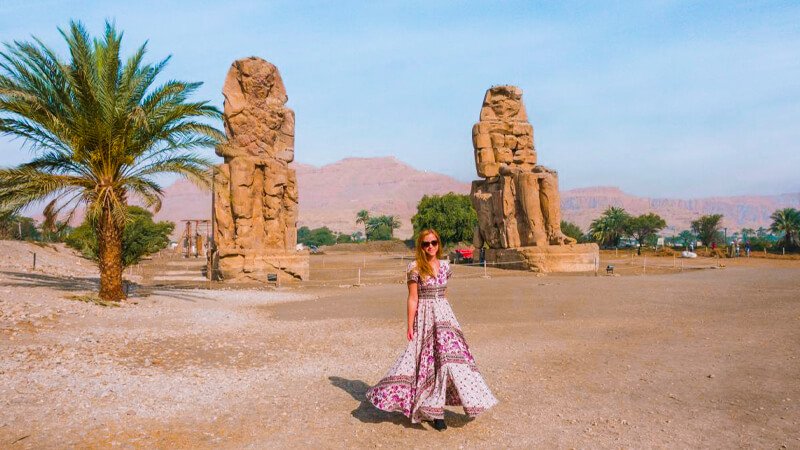The Colossi of Memnon, two towering statues that have withstood the test of time, stand as guardians to the ancient city of Thebes (modern-day Luxor). These iconic monuments are deeply rooted in the history of ancient Egypt, serving as a window into the past and attracting travelers from all over the world. Towering at 18 meters (60 feet) high, these statues were originally created to represent Pharaoh Amenhotep III, who reigned during the 18th Dynasty. They were designed to stand at the entrance to his mortuary temple, which was one of the largest complexes in Egypt, though it has now largely disappeared due to the passage of time and natural disasters.
The History and Construction of the Colossi of Memnon
Constructed around 1350 BCE, the Colossi of Memnon were crafted from quartzite sandstone, which was transported from quarries near Cairo, more than 675 kilometers away. This feat of ancient engineering speaks volumes about the capabilities of the Egyptians at the time. Pharaoh Amenhotep III, known for his wealth and monumental building projects, commissioned the statues to honor his legacy and ensure his place in the afterlife. The mortuary temple that originally surrounded the statues has long since disappeared due to natural disasters and the annual Nile floods, but the Colossi remain. Although weathered by time, they still stand proudly, offering a glimpse into Egypt’s glorious past.
The Mythology Behind the Name “Memnon”
The Colossi of Memnon acquired their name from a piece of Greek mythology. According to legend, Memnon was an Ethiopian king and a hero of the Trojan War who was slain by Achilles. After his death, Memnon was immortalized in Egyptian lore, and the statues became associated with him because of the sound one of them made every morning. This “singing” was believed to be Memnon greeting his mother, Eos, the goddess of dawn. The phenomenon was likely caused by the warming of the stone after the cool nights, which led to cracks and fissures emitting sound. Although the singing ceased after a restoration in 199 CE by Roman Emperor Septimius Severus, the legend remains a fascinating aspect of the statues’ history.
Architectural Significance of the Colossi
From an architectural perspective, the Colossi of Memnon are remarkable not only for their sheer size but also for their detailed craftsmanship. The statues depict Amenhotep III seated on a throne, his hands resting on his knees, and gazing eastward toward the rising sun. The throne is decorated with carvings depicting the Nile god Hapi uniting Upper and Lower Egypt, symbolizing the pharaoh’s control over the entire kingdom. Despite the erosion and damage over the centuries, the grandeur and artistry of these statues are still evident. For travelers and history enthusiasts, they are a testament to the skill and vision of ancient Egyptian artisans.
The Importance of the Colossi in Ancient Egyptian Religion
In ancient Egypt, statues like the Colossi of Memnon played an important role in religious practices. Pharaohs were considered divine beings, intermediaries between the gods and the people, and their mortuary temples were built not just as tombs but as places of worship. The Colossi, in their original form, would have been part of a grand ceremonial process in which offerings were made to ensure the king’s safe journey to the afterlife. As visitors approach these statues today, they are walking in the footsteps of ancient Egyptians who once came to honor their deceased ruler, offering insights into the religious and spiritual beliefs of that time.
Visiting the Colossi of Memnon Today
For modern travelers, visiting the Colossi of Memnon is an essential stop when exploring Luxor’s west bank. Standing in the shadow of these enormous statues, one cannot help but feel awe for the accomplishments of ancient Egyptian society. Though the mortuary temple has mostly disappeared, the statues remain as a poignant reminder of a bygone era. Many tours to the Colossi are combined with visits to nearby attractions, such as the Valley of the Kings, the Temple of Hatshepsut, and the Ramesseum. Tourists are advised to visit early in the morning to avoid the heat and to witness the statues in the soft light of dawn, when they are at their most majestic.
The Role of the Colossi in Modern Archaeological Efforts
Archaeologists continue to study the Colossi of Memnon and the remains of the temple complex to gain further insight into Amenhotep III’s reign. Recent excavations have uncovered new statues and fragments, shedding light on the layout and scale of the temple. These discoveries contribute to a deeper understanding of the engineering techniques and religious practices of ancient Egypt. Efforts to preserve and restore the site are ongoing, with the goal of protecting these historical treasures for future generations of travelers and historians.
Exploring the Surrounding Area: Luxor’s West Bank
The Colossi of Memnon are located in one of the most historically rich areas of Egypt—Luxor’s west bank. This region is home to some of the most significant archaeological sites in the world, including the Valley of the Kings, where the tomb of Tutankhamun was discovered, and the Temple of Hatshepsut, an architectural marvel dedicated to one of Egypt’s few female pharaohs. Travelers to the west bank often combine their visit to the Colossi with these nearby attractions, making it an ideal destination for anyone interested in Egypt’s ancient history. Luxor itself is often referred to as the world’s greatest open-air museum, and the Colossi are one of its most iconic features.
The Restoration of the Colossi: A Continuous Effort
Over the centuries, the Colossi of Memnon have suffered from erosion, earthquakes, and other natural disasters. Efforts to restore the statues date back to Roman times, but more recent preservation techniques are being employed to maintain their structural integrity. Modern archaeological teams are using advanced technologies, such as 3D scanning and digital mapping, to monitor the statues’ condition and assess the effectiveness of restoration efforts. These measures ensure that the Colossi will continue to stand for future generations, preserving an important piece of ancient Egyptian heritage.
How to Plan Your Visit to the Colossi of Memnon
If you’re planning a trip to Egypt, visiting the Colossi of Memnon should be at the top of your list. Most tourists visit the site as part of a guided tour, which often includes other nearby attractions. The best time to visit is in the early morning or late afternoon when the sun is lower in the sky, creating a beautiful golden light that enhances the statues’ features. The site is open to the public, and there is no entrance fee, making it a convenient stop for any traveler. Be sure to bring water, a hat, and sunscreen, as the Luxor sun can be intense, especially during the summer months.
Cultural and Symbolic Relevance in Modern Times
The Colossi of Memnon continue to captivate not only historians but also the general public. Their symbolic significance goes beyond their original purpose. In modern times, they serve as a powerful reminder of human creativity and the quest for immortality through art and architecture. The site attracts not only history buffs but also photographers, artists, and even spiritual seekers who come to reflect on the mysteries of ancient Egypt. The statues’ imposing presence on the horizon is a source of inspiration, embodying the enduring legacy of one of the world’s greatest civilizations.
Conclusion: The Colossi of Memnon as Timeless Sentinels of Egypt’s Past
The Colossi of Memnon stand as timeless sentinels, guarding the memories of a civilization that has fascinated people for millennia. For travelers to Egypt, these statues offer not just a glimpse into the grandeur of the past, but also a moment of reflection on the passage of time and the enduring power of human achievement. As Egypt continues to reveal its secrets through archaeology and research, the Colossi remain a focal point for those who seek to understand the depth of this ancient culture. Whether you are a seasoned historian or a curious traveler, a visit to the Colossi of Memnon is a journey into the heart of ancient Egypt’s majesty.

